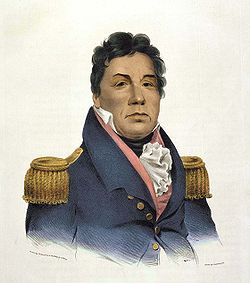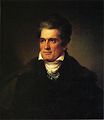
Treaty of Washington City
Encyclopedia
The Treaty of Washington City was a treaty signed on January 20, 1825 (proclaimed on February 19, 1825) between the Choctaw (an American Indian
tribe) and the United States Government.
) to discuss encroaching settlement and to seek the expulsion of settlers or financial compensation. The group also included Talking Warrior, Red Fort, Nittahkachee, Col. Robert Cole and David Folsom, both half-breed
Indians, Captain Daniel McCurtain, and Major John Pitchlynn, the U.S. Interpreter.
The proposed route to Washington was to travel the Natchez trace to Nashville, Tennessee
, then to Lexington, Kentucky
, onward to Maysville, Kentucky
, across the Ohio River
northward to Chillicothe, Ohio
, (former principal town of the Shawnee), then finally east over the “National Highway” to Washington City.
 .
.
Pushmataha met with President James Monroe
and gave a speech to Secretary of War John C. Calhoun
, reminding him of the longstanding alliances between the United States and the Choctaws. He said, "[I] can say and tell the truth that no Choctaw ever drew his bow against the United States ... My nation has given of their country until it is very small. We are in trouble."."
While in Washington, Pushmataha sat for a portrait by Charles Bird King in his Army uniform; it hung in the Smithsonian Institution
until 1865.
Pushmataha also met with the Marquis de Lafayette, who was visiting Washington City. Pushmataha said, "Nearly fifty snows have melted since you drew your sword with Washington and fought the enemies of the United States ... Our hearts have longed to see you."
The treaty had the following abbreviated terms,
1. Lands ceded to the United States.
2. $6,000 to be paid to Choctaws annually, forever.
3. $6,000 to be paid them annually for 16 years.
4. Provision for Choctaws who may desire to remain.
5. A certain debt due by Choctaws relinquished.
6. Payment for services rendered in the Pensacola campaign.
7. Fourth article of the aforesaid treaty to be modified. The Congress of the United States shall not exercise the power of apportioning the lands ... and of bringing them under the laws of the United States, but with the consent of the Choctaw Nation.
8. Payment to satisfy claims due by United States.
9. An agent and blacksmith for Choctaws west of the Mississippi.
10. Robert Cole to receive a medal.
11. Friendship perpetuated.
12. When to take effect.
 Apuckshunubbee died in Maysville, Kentucky; and Pushmataha died in Washington. Apuckshunubbee was reported to have died from a broken neck caused by a fall from a hotel balcony. Other historians say he fell from a cliff.
Apuckshunubbee died in Maysville, Kentucky; and Pushmataha died in Washington. Apuckshunubbee was reported to have died from a broken neck caused by a fall from a hotel balcony. Other historians say he fell from a cliff.
Pushmataha died of croup
, even though the disease usually only afflicts infants and young children. Apuckshunubee's successor was Robert Cole and later Greenwood LeFlore
. Pushmataha's successor was Nittakechi. The deaths of these two leaders effectively crippled the Choctaw Nation. Within six years the Choctaw were forced to cede their last remaining territory in Mississippi to the United States.
Native Americans in the United States
Native Americans in the United States are the indigenous peoples in North America within the boundaries of the present-day continental United States, parts of Alaska, and the island state of Hawaii. They are composed of numerous, distinct tribes, states, and ethnic groups, many of which survive as...
tribe) and the United States Government.
Overview
Apuckshunubbee, Pushmataha, and Mosholatubbee, the principal leaders of the Choctaws, went to Washington City (the 19th century name for Washington, D.C.Washington, D.C.
Washington, D.C., formally the District of Columbia and commonly referred to as Washington, "the District", or simply D.C., is the capital of the United States. On July 16, 1790, the United States Congress approved the creation of a permanent national capital as permitted by the U.S. Constitution....
) to discuss encroaching settlement and to seek the expulsion of settlers or financial compensation. The group also included Talking Warrior, Red Fort, Nittahkachee, Col. Robert Cole and David Folsom, both half-breed
Half-breed
Half-breed is an historic term used to describe anyone who is mixed Native American and white European parentage...
Indians, Captain Daniel McCurtain, and Major John Pitchlynn, the U.S. Interpreter.
The proposed route to Washington was to travel the Natchez trace to Nashville, Tennessee
Nashville, Tennessee
Nashville is the capital of the U.S. state of Tennessee and the county seat of Davidson County. It is located on the Cumberland River in Davidson County, in the north-central part of the state. The city is a center for the health care, publishing, banking and transportation industries, and is home...
, then to Lexington, Kentucky
Lexington, Kentucky
Lexington is the second-largest city in Kentucky and the 63rd largest in the US. Known as the "Thoroughbred City" and the "Horse Capital of the World", it is located in the heart of Kentucky's Bluegrass region...
, onward to Maysville, Kentucky
Maysville, Kentucky
Maysville is a city in and the county seat of Mason County, Kentucky, United States. The population was 8,993 at the 2000 census, making it the fiftieth largest city in Kentucky by population. Maysville is on the Ohio River, northeast of Lexington. It is the principal city of the Maysville...
, across the Ohio River
Ohio River
The Ohio River is the largest tributary, by volume, of the Mississippi River. At the confluence, the Ohio is even bigger than the Mississippi and, thus, is hydrologically the main stream of the whole river system, including the Allegheny River further upstream...
northward to Chillicothe, Ohio
Chillicothe, Ohio
Chillicothe is a city in and the county seat of Ross County, Ohio, United States.Chillicothe was the first and third capital of Ohio and is located in southern Ohio along the Scioto River. The name comes from the Shawnee name Chalahgawtha, meaning "principal town", as it was a major settlement of...
, (former principal town of the Shawnee), then finally east over the “National Highway” to Washington City.
Meetings while in Washington City

Pushmataha met with President James Monroe
James Monroe
James Monroe was the fifth President of the United States . Monroe was the last president who was a Founding Father of the United States, and the last president from the Virginia dynasty and the Republican Generation...
and gave a speech to Secretary of War John C. Calhoun
John C. Calhoun
John Caldwell Calhoun was a leading politician and political theorist from South Carolina during the first half of the 19th century. Calhoun eloquently spoke out on every issue of his day, but often changed positions. Calhoun began his political career as a nationalist, modernizer, and proponent...
, reminding him of the longstanding alliances between the United States and the Choctaws. He said, "[I] can say and tell the truth that no Choctaw ever drew his bow against the United States ... My nation has given of their country until it is very small. We are in trouble."."
While in Washington, Pushmataha sat for a portrait by Charles Bird King in his Army uniform; it hung in the Smithsonian Institution
Smithsonian Institution
The Smithsonian Institution is an educational and research institute and associated museum complex, administered and funded by the government of the United States and by funds from its endowment, contributions, and profits from its retail operations, concessions, licensing activities, and magazines...
until 1865.
Pushmataha also met with the Marquis de Lafayette, who was visiting Washington City. Pushmataha said, "Nearly fifty snows have melted since you drew your sword with Washington and fought the enemies of the United States ... Our hearts have longed to see you."
Terms
The preamble begins with,The treaty had the following abbreviated terms,
1. Lands ceded to the United States.
2. $6,000 to be paid to Choctaws annually, forever.
3. $6,000 to be paid them annually for 16 years.
4. Provision for Choctaws who may desire to remain.
5. A certain debt due by Choctaws relinquished.
6. Payment for services rendered in the Pensacola campaign.
7. Fourth article of the aforesaid treaty to be modified. The Congress of the United States shall not exercise the power of apportioning the lands ... and of bringing them under the laws of the United States, but with the consent of the Choctaw Nation.
8. Payment to satisfy claims due by United States.
9. An agent and blacksmith for Choctaws west of the Mississippi.
10. Robert Cole to receive a medal.
11. Friendship perpetuated.
12. When to take effect.
Signatories
J. C. Calhoun, Mooshulatubbee, Robert Cole, Daniel McCurtain, Talking Warrior, Red Fort, Nittuckachee, David Folsom, J. L. McDonald, Thos. L. McKenney, Hezekiah Miller, andJohn Pitchlynn ( United States interpreter).Aftermath

Pushmataha died of croup
Croup
Croup is a respiratory condition that is usually triggered by an acute viral infection of the upper airway. The infection leads to swelling inside the throat, which interferes with normal breathing and produces the classical symptoms of a "barking" cough, stridor, and hoarseness...
, even though the disease usually only afflicts infants and young children. Apuckshunubee's successor was Robert Cole and later Greenwood LeFlore
Greenwood LeFlore
Greenwood LeFlore or Greenwood Le Fleur was elected Principal Chief of the Choctaw in 1830 before removal. Before that, the nation was governed by three district chiefs and a council of chiefs...
. Pushmataha's successor was Nittakechi. The deaths of these two leaders effectively crippled the Choctaw Nation. Within six years the Choctaw were forced to cede their last remaining territory in Mississippi to the United States.
See also
- List of Choctaw Treaties
- Treaty of HopewellTreaty of HopewellThe Treaty of Hopewell is any of three different treaties signed at Hopewell Plantation. The plantation was owned by Andrew Pickens, and was located on the Seneca River in northwestern South Carolina. The treaties were signed between the Confederation Congress of the United States of America and...
- Treaty of Fort AdamsTreaty of Fort AdamsThe Treaty of Fort Adams was signed on December 17, 1801 between the Choctaw and the United States Government. The treaty ceded about of Choctaw land...
- Treaty of Fort ConfederationTreaty of Fort ConfederationThe Treaty of Fort Confederation was signed on October 17, 1802 between the Choctaw and the United States Government. The treaty ceded about of Choctaw land, including the site of Fort Tombecbe, also known as Fort Confederation....
- Treaty of Hoe BuckintoopaTreaty of Hoe BuckintoopaThe Treaty of Hoe Buckintoopa was signed on August 31, 1803 between the Choctaw and the United States Government. The treaty ceded about of Choctaw land.-Terms:The preamble begins with,1...
- Treaty of Mount DexterTreaty of Mount DexterThe Treaty of Mount Dexter was signed between the United States and the Choctaws. The treaty was signed November 16, 1805. The area ceded was from the Natchez District to the Tombigbee Alabama River watershed, mostly in present-day Mississippi.-Terms:...
- Treaty of Fort St. StephensTreaty of Fort St. StephensThe Treaty of Fort St. Stephens or Treaty of Choctaw Trading House was signed between the United States and the Choctaws. The treaty was signed at the Choctaw trading house on October 24, 1816. It ceded of Choctaw land east of the Tombigbee River. The land was exchanged for 6,000 US dollars...
- Treaty of Doak's StandTreaty of Doak's StandThe Treaty of Doak's Stand was signed on October 18, 1820 between the United States and the Choctaw Indian tribe. Based on the terms of the accord, the Choctaw agreed to give up approximately one-half of their remaining Choctaw homeland...
- Treaty of Dancing Rabbit CreekTreaty of Dancing Rabbit CreekThe Treaty of Dancing Rabbit Creek was a treaty signed on September 27, 1830 between the Choctaw and the United States Government. This was the first removal treaty carried into effect under the Indian Removal Act...
- List of treaties

